|

songs | interviews | photos | tours | boots | press releases | timeline
Keyboard Player (UK)
January 2009
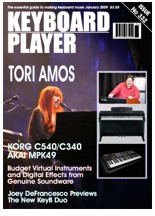
Download PDF
Singer-songwriter Tori Amos talks to Douglas McPherson about her creative process and her battle for creative freedom.
It's hard to believe that Tori Amos has been part of our lives for nearly 20 years now. In that time, the singer-songwriter has sold more than 12 million albums. But a new DVD, Live At Montreux 1991 & 1992, takes us right back to the beginning.
For her first appearance at the Montreux Jazz Festival, Amos was an unknown opener; she was yet to release Little Earthquakes, the album that would launch her name around the world. Her second appearance, a year later, came just after the album's release, when she was well on her way.
Looking back at that pivotal time in her life, the North Carolina native says, "It seems to me that the woman in that 1991 performance walked into a place that didn't know how to pronounce her name. When that happens, that means there's no expectation from you as an artist. And that doesn't happen a lot in your life, if you're gonna be successful.
"It's a magical period when no one has said negative things about you before you've walked on the stage. Nobody is expecting you to wow them or give them anything special. It's a clean slate. Anything can happen. And if magic happens, you begin the sort of romance that can occur between you and the media. That's what happened there."
Not that there are any overnight successes in the music business. It's usually a case of opportunity meets long preparation, and there is a good reason why the youthful Amos looks so assured at the piano in that first video.
"I'd been playing professionally for 13 years before then, not to big audiences like that, but to people. And it's so important that that be acknowledged, because it's not as if I'd only played to my living room, although I might have said that (on stage at Montreux). I'd been playing in lounges since I was about 13-years-old.
"So I was comfortable in front a piano. But also, there was no pressure on me. Sure, there were nerves and butterflies, but it wasn't as if the press was going to slam me the next day, even if I was bad, because no one knew who I was."
As for her return visit to Montreux: "I'd been playing a lot by then, in front of a lot of people. I had a successful record on both sides of the Atlantic and the romance with the media was still going on. But by then, people are waiting for you to fall. It's something that happens to everybody, if you hang around long enough. They're gonna wait for you to fall, and I was aware of that, by that time, in '92."
Winding back further in time, to the beginning of her relationship with the piano, Amos says, "I can't remember not playing. It's something I've always done. It's been the centre of every day of my life, even to the point of falling asleep on it. It's just a part of my being. I'm connected to it.
You can't see that I'm connected to it physically," she continues, "but there's an invisible cord that goes from me, I'd say from the back of my spine, to the piano."
Even when she's not seated at the piano, Amos says the cord remains securely fastened. "These days, I carry the piano with me. Not physically. But I'm never separated from the idea of it. I think visual artists can do this as well. Just because they're not literally painting, does not mean they're not composing something in their mind. So you become a creative force, every waking and breathing moment of your life. It just becomes integrated with who you are. If you work towards that."
When she's neither performing nor recording, Amos says she plays at least a couple of hours every day. "I wouldn't call it practice, although hopefully you're getting that done as well. I would say more than anything, it's about communing. There are people who go out and
commune with nature every day, whether they're walking their dog, or just out in nature, because they need to be out in it. Well I spend time being in the music."
Her piano of choice is the Bosendorfer. "They're handmade and each one is an individual. Every single one I've played is unique. If somebody who was working on it that day caught his wife with another man, then that instrument is going to have a different attack than if, say, he's just found a new lover and it's all swimmingly peachy." With a laugh, she adds, "Those guys told me that when I was in Vienna, meeting with them!"
Perhaps one reason Amos has such an affinity with the character of one the pianos she plays is because, as a songwriter, she is very much in touch with her spiritual side. "I've always believed that the song already exists and they're crossing dimensions to get to me, to bring them into this dimension on what I'm going through, it's gonna affect how I interpret it."
Not that songs pop fully formed into her head like gifts from above, Amos adds. There's a strong element of craft involved, too. "There isn't just one way to compose. You can put aside time to sit down every day, no matter where you are in the world, to write. That doesn't always bring you your work.
"But what it can do is develop your vocabulary and your song-writing palette. So when you are just walking down the road and this phrase comes into your mind and you know it's special, then you take it back to your workshop and you say, yeah, but I don't have a bridge, and I don't have all the components. So you start looking at your compositional palette and maybe you find something that you can slip in."
"Over the years, I've developed many different movements that can be dropped in. They're just waiting for the moment."
Recently, Amos was writing to order, for a musical called The Light Princess, which is hoped to open this year at the National Theatre. "My brief was to come up with a processional a beginning, and my role model, I guess you could say, was the beginning of West Side Story."
"Little did I realise, " Amos laughs, "that some people on the team had fantasies that I would come up with a whole different approach like an Oklahoma or a Carousel, stuff my mother was crazy about!
"I was looking towards a more Wagnerian approach and in order to do that, I will open my mind to a certain time period in music. I will study those structures and the chord progressions used at that time.... and so we go back to that phrase, my compositional vocabulary or palette. Sometimes I'll have a palette working solely for that song."
When it comes to confessional song-writing, Amos warns "It's one thing to use your journal as a jumping-off point. But just because somebody's going on and on about their broken heart, that doesn't make it great art You have to be able to take the energy of your experience and weave it in a way that makes me, the listener, want to care about it."
One way of doing that, she declares, is to stop looking at your experiences solely from your own point of view. "Many times I've gone my God, this works so much better if I turn the tables and sing about what happened from the guy's point of view. Sometimes when I really get into a song, I begin to see, 'Oh wait a minute, what is my part in this?' And I decide to play the protagonist, because it's a much stronger point of view. In the song Professional Widow, for example, it's much stronger to be the aggressive one."
Like all artists with a unique and original vision, Amos initially struggled to get her music heard After years playing piano bars she signed a contract with Atlantic Records only to be told: "You have to do a pop-rock record that's like this."
"I remember thinking across town they're making a record with another, then unknown, artist called Tracy Chapman Why are they okay about backing a singer-songwriter with a guitar but not a piano? And I kept getting, just from label consciousness, you know, 'the piano died out with Carole King honey'.
"I thought, it just needs to be shown in a different light But at that point, I realised that if I was going to be even given a budget to make a record, I had to play a game."
So Amos made an album the record company's way. It was called Y Kant Tori Read, after the fact that while she has always had an exemplary ear for music she never developed the knack of playing from a score. And it was a complete flop. Looking back, Amos recalls, "You should have heard the material I was working on before Y Kant Tori Read, that would have really curled your toes!"
But then she adds, "The greatest thing that ever happened was that that record bombed. At the time, I just wanted to walk away from the whole experience. But Doug Morris from Atlantic came to see me in my little place in Hollywood. He sat in my little one room apartment behind the Hollywood Methodist church I was playing him stuff and he just said, 'Go make a record doing what it is you do'. That was the Little Earthquakes album, and the of where I am."
Amos is one of only a handful of female singers to achieve five or more Top 10 albums on the US charts, most recently with The Beekeeper in 2005 However, she stresses that success is no guarantee of winning creative freedom.
"You get freedom for spurts. Then at other times you'll be dealing with people in very powerful positions at a label who just like what they like, and they're God You have people who will turn around and say, 'We thought you were gonna write us something like this.' I'll say, 'Yes but I've just given you a variation on a theme of a Debussy piece, in pop music.' They'll look at me and say, 'Who cares about Debussy?'
It was to avoid conflicts like that that led Amos to leave Sony and fund from her own pocket the project she is currently working on. "It's very much about the marriage of film and music. Think silent films, but centred around a song. It's not a video. I'm calling them Visualettes. The story comes to you from the film and the song together."
"I had to become my own investor because, in this day and age, if you turn around and say, 'I want to produce 17 short films and 17 songs...' they're looking at you and saying, 'Not on our dime you're not.'
That's true of an indie as well as a giant, because an indie doesn't have enough money. Everyone wants a guaranteed return, and with the economic situation the way it is that means the ability to be brave is being aborted by the fear of our times."
"By leaving the Sony system I knew that if I could be the investor in the artist Tori Amos, then the work could be taken to its final moment on the creative side, before it gets meddled with. If you're not holding those financial cards, if you have to partner with someone, then you have to open the door, and I don't think records can be made as a democracy."
So what advice would she offer the young singer-songwriter about to embark on a career in the music business? She pauses to consider.
"You have to know that styles go in phases. So although the music you're making might not sound like anything on the radio and it might not sound like it's your time now, that can turn on a dime, and you can be the one to it turn. But you need to make sure that when you're working with producers that they share a similar vision, that you're all in the same galaxy." She chuckles, "It doesn't have to be the same solar system, but it had better be the same galaxy! Because otherwise you can make a record that is purely produced and you cannot reproduce it live if your life depended on it."
"The other thing you have to be aware of is that the technology is so good now that you can take somebody who's an okay singer but a really pretty girl and make her sound a lot better than she does. Then the professional songwriters and producers come in and develop that talent around their own vision. With shows like the X-Factor there's a lot more music coming from that side of things. So the competition is greater, because there's only so much money and there are only so many artists they're going to sign.
"But to be a singer-songwriter means you're not in that loop. Models, everybody, can sing. But not everybody can write a song and not everybody can play an instrument. So I encourage people to play their instruments and perform their own work, because that is special."
original article
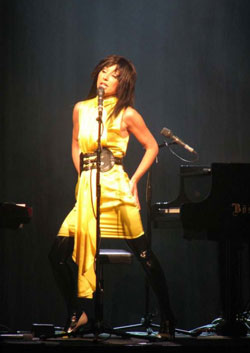
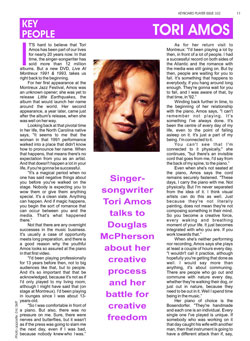
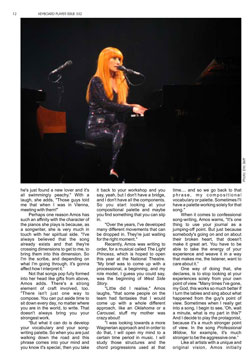
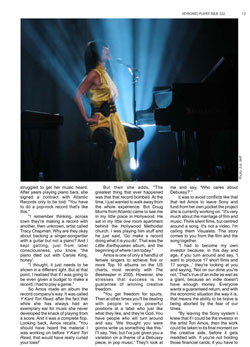
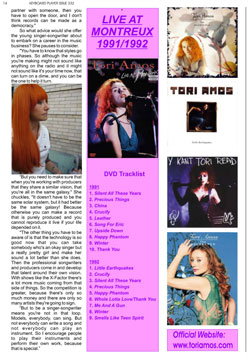
t o r i p h o r i a
tori amos digital archive
yessaid.com
|